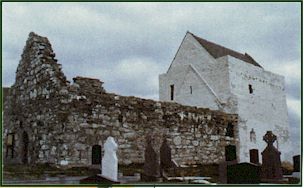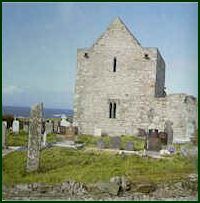| 1. Symposia / Historical Safaris
3. Research 4. Surveys 7. Folklore
9. Contact us 11. Links |
St. BRIGID'S ABBEY
Clare Island Abbey is located on the south
side of the island, approximately a mile from the harbour. It consists of a nave and
chancel church, the later surmounted by a barrel vault and a domestic chamber on the first
storey. As a Cistercian cell, it is the most westerly of the possessions and houses of that order, and the only such one to be located on an island. In fact, apart from Clare Island and Abbey Knockmoy, which is located a considerable distance inland in north Galway, only one other Cistercian house was located west of Shannon. From the 13th century, the Cistercians had quickly established themselves in Ireland, having come from the continent, especially France. They built their abbeys and monasteries on the richest and most productive land, which is to be found in the middle and southern parts of the country. The anomaly of the existence of the Clare Island Cistercian cell may be explained by the ambitions of the O'Malley clan, whose stronghold Clare Island was. It was common for clans to try and woo these new orders of monasticism to locate within their territory. The prestige of the Cistercians would only accentuate the status of the O'Malley clan and extend, or make weightier, their local influence. Near the Abbey, on the southwest side within
the graveyard stands a fine standing stone,eleven feet height by eighteen and a half
inches thick. It is inscribed with a latin cross and is a good example of the
Christianisation of pagan monuments. It is not in its original location but was moved to
the present spot at the turn of the century. Outside the graveyard walls, to the nortwest
of the Abbey is a holy well, Tober feile Mhuire, the well of the feast of Mary.
Now delapidated and disused for at least fifty years, its existence, taken together with
the standing stone, offer an expalnation for the location of the Abbey: the colonisatation
by the established church of pre-Christian holy places. The chancel of the Abbey was roofed about fifty years ago. The outside of the chancel received a layer of limeplaster in 1995 in an effort to stabilize the climatic conditions for the unique medieval paintings on the walls and ceiling. Additional notable features in the Abbey are the traceried tomb in wich the legendary "Pirate Queen" or Grace O'Malley is said to be interred and the 17th century coat of arms of the O'Malleys. There is also a "squint" in the north wall of the chancel, six foot by three foot which may have been used by a penitent or an anchorite.
|
 Though referred to locally as an "abbey", it is, in fact,
a cell. It is said originally to have been a Carmelite Cell dedicated to the Blessed
Virgin dating to around 1224. A footnote in "The illustrated Guide to the Northern,
Western and Southern Islands and Coast of Ireland" produced by the Royal Society of
Antiquaries of Ireland in 1905,states: "In 1235 the two sons of Murray O'Malley were
slain by Donnal O;Connor and Nial Roe O'Connor in Cliara and were interred there".
However the 13th century date seems far too early for the present structure, which is
dated as being 15th century and may have been built upon the earlier ecclesiastical site.
The abbey became part of the possessions of the Cistercian house of Abbey Knockmoy,
as daughter house.
Though referred to locally as an "abbey", it is, in fact,
a cell. It is said originally to have been a Carmelite Cell dedicated to the Blessed
Virgin dating to around 1224. A footnote in "The illustrated Guide to the Northern,
Western and Southern Islands and Coast of Ireland" produced by the Royal Society of
Antiquaries of Ireland in 1905,states: "In 1235 the two sons of Murray O'Malley were
slain by Donnal O;Connor and Nial Roe O'Connor in Cliara and were interred there".
However the 13th century date seems far too early for the present structure, which is
dated as being 15th century and may have been built upon the earlier ecclesiastical site.
The abbey became part of the possessions of the Cistercian house of Abbey Knockmoy,
as daughter house.